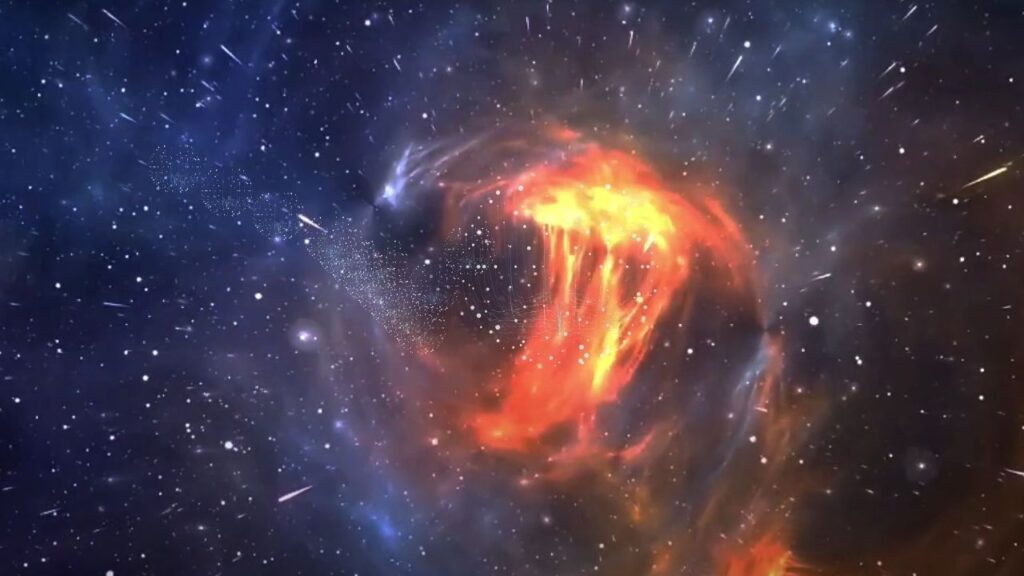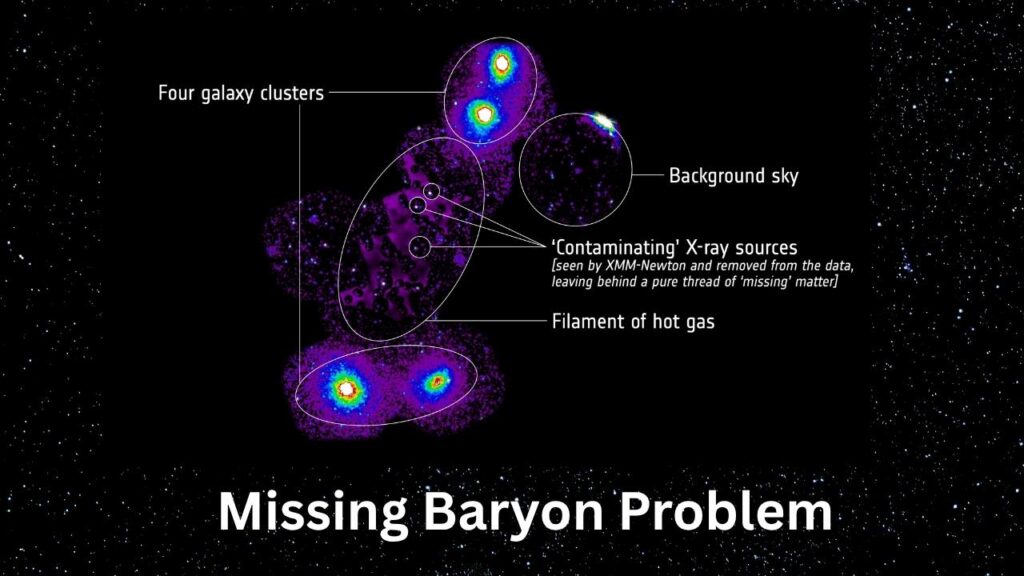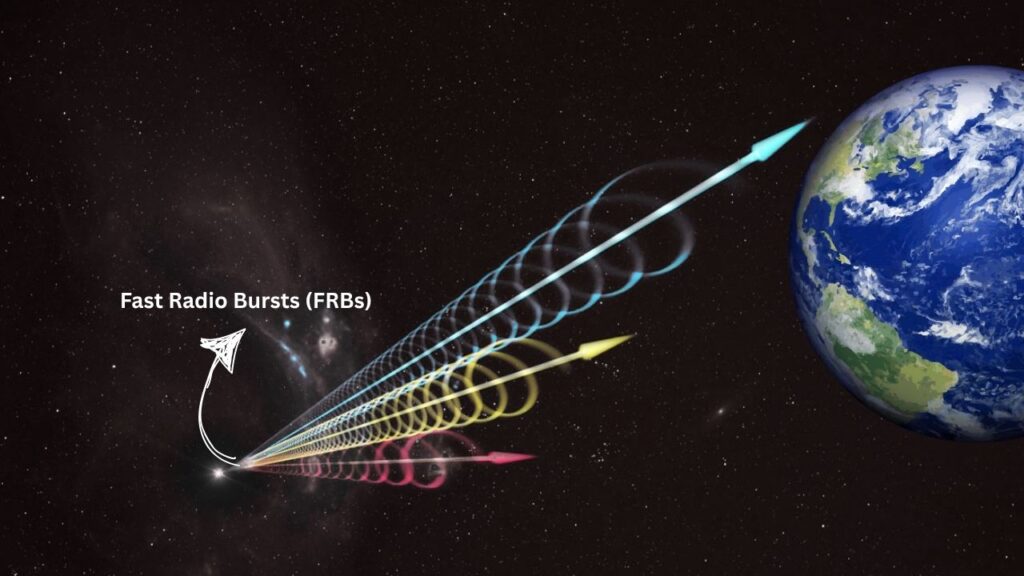Presence of Elusive Cosmic Matter Hidden Within Giant Structures: The universe is a vast and mysterious place, filled with wonders that have puzzled scientists for generations. One of the most intriguing mysteries has been the missing baryon problem—the search for ordinary matter that seemed to have vanished from the cosmos.

In a groundbreaking discovery, astronomers have now confirmed the presence of this elusive cosmic matter hidden within giant structures, supporting long-standing theories about the universe’s makeup and evolution.
What Is the Missing Baryon Problem?
For over two decades, scientists have been trying to solve the puzzle of the universe’s “missing” ordinary matter, also known as baryonic matter. Baryons are particles like protons and neutrons—the building blocks of atoms that make up everything we see around us: stars, planets, and even ourselves. But when astronomers counted all the visible matter in the universe, they found only about half of what was predicted by theories and early measurements of the universe’s composition.
This discrepancy became known as the missing baryon problem, and it has been a major focus of cosmological research for decades.
Presence of Elusive Cosmic Matter Hidden Within Giant Structures
| Key Point | Details |
|---|---|
| What are baryons? | Ordinary matter made of protons and neutrons (everything we see, touch, and are made of). |
| Percentage of universe that is baryonic matter | About 5% (rest is dark matter and dark energy). |
| How much was missing? | About half of the predicted baryonic matter was unaccounted for. |
| Where was it found? | In hot, low-density gas between galaxies (intergalactic medium), forming the cosmic web. |
| How was it discovered? | Using fast radio bursts (FRBs) as cosmic probes to “weigh” the invisible matter. |
| What percentage is in the intergalactic medium? | About 76% of all baryonic matter. |
| Official resource for further reading | Harvard-Smithsonian Center for Astrophysics |
The confirmation of the universe’s missing baryonic matter is a triumph of modern astronomy. By using fast radio bursts as cosmic flashlights, scientists have illuminated the vast, invisible structures that hold most of the universe’s ordinary matter. This discovery not only solves a decades-old cosmic mystery but also opens new doors for exploring the universe’s grand design. The journey from puzzling over missing matter to finally finding it shows the power of curiosity, innovation, and teamwork in science.

Understanding the Universe’s Ordinary Matter
What Are Baryons?
Baryons are a type of particle that includes protons and neutrons, which together form the nuclei of atoms. All the “stuff” we interact with—air, water, rocks, plants, animals, and stars—is made of baryonic matter.
But baryons only make up a small fraction of the universe. According to measurements from the cosmic microwave background (the afterglow of the Big Bang) and studies of the early universe, baryonic matter should account for about 4.8% to 5% of the universe’s total energy content.
The Search for the Missing Matter
When astronomers tried to tally up all the baryonic matter in the modern universe—counting stars, galaxies, gas clouds, and everything else they could see—they found less than half of what theory predicted. This led to the missing baryon problem: Where was the rest of the ordinary matter hiding?
How Did Astronomers Solve the Mystery?
The Role of Fast Radio Bursts (FRBs)
The breakthrough came with the discovery and use of fast radio bursts (FRBs). FRBs are mysterious, millisecond-long flashes of radio waves that come from distant galaxies. While scientists are still working to understand what causes FRBs, they realized these bursts could be used as cosmic probes.

When an FRB travels through space, it passes through the intergalactic medium—the thin, hot gas that fills the vast spaces between galaxies. As the radio waves move through this gas, they slow down slightly, depending on how much matter they encounter. By carefully measuring this delay, astronomers can “weigh” the otherwise invisible gas.
“The FRBs shine through the fog of the intergalactic medium, and by precisely measuring how the light slows down, we can weigh that fog, even when it’s too faint to see,” explains Liam Connor, lead author of a recent study published in Nature Astronomy.
Mapping the Cosmic Web
Using data from dozens of FRBs, astronomers were able to map out where the missing baryons were hiding. They found that about 76% of all ordinary matter is in the form of hot, low-density gas between galaxies, woven into a vast network known as the cosmic web. About 15% is in the halos around galaxies, and the rest is inside stars or cold galactic gas.
This discovery matches the predictions of cosmological models and solves the missing baryon problem that has puzzled scientists for decades.
Why Is This Discovery Important?
Understanding the Universe’s Structure
The confirmation that most ordinary matter is spread out in the cosmic web helps scientists understand how galaxies form and evolve. The cosmic web acts as a scaffold for the universe, guiding the flow of gas and matter that eventually forms stars and galaxies.
Implications for Cosmology
- Validates Theories: The discovery supports long-standing theories about the universe’s composition and evolution.
- Improves Models: Knowing where the baryons are allows cosmologists to create more accurate models of galaxy formation and the large-scale structure of the universe.
- Opens New Avenues: The use of FRBs as cosmic probes opens up new ways to study the universe’s hidden matter and the processes that shape it.
How Can This Knowledge Be Used?
For Students and Enthusiasts
- Understanding Cosmic Evolution: Learning about the missing baryon problem and its solution offers a window into how science works—solving mysteries through observation, theory, and new technology.
- Exploring the Universe: The discovery encourages curiosity about the universe’s structure and the tools astronomers use to study it.
For Professionals
- Astrophysics Research: The findings provide a foundation for further studies of the intergalactic medium, galaxy formation, and cosmic evolution.
- Technology Development: The use of FRBs demonstrates the importance of developing new observational techniques and instruments.
For Educators
- Teaching Resource: The story of the missing baryon problem is an excellent example of scientific inquiry and perseverance, suitable for classrooms at all levels.
Step-by-Step Guide: How Astronomers Found the Universe’s Missing Matter
1. Identifying the Problem
- Scientists noticed a mismatch between the predicted amount of baryonic matter and what was observed in stars, galaxies, and gas clouds.
2. Developing New Tools
- Traditional telescopes couldn’t see the faint, hot gas in the intergalactic medium. Astronomers needed a new way to detect it.
3. Discovering Fast Radio Bursts
- FRBs, discovered in 2007, provided a new tool for probing the universe’s hidden matter.
4. Using FRBs as Cosmic Probes
- By measuring how FRBs are slowed as they pass through intergalactic gas, astronomers could estimate the amount of matter in the cosmic web.
5. Analyzing the Data
- Studies of dozens of FRBs from nearby and distant galaxies allowed astronomers to map the distribution of baryonic matter.
6. Confirming the Results
- The results matched theoretical predictions: most baryonic matter is in the intergalactic medium, solving the missing baryon problem.
Astronomers Identify New Kind of Cosmic Explosion Far Brighter Than Supernovae
Tiny Nanoneedle Cancer-Detection Patch May Replace Painful Biopsies
Summer Solstice 2025 Marks Official Start Of Northern‑Hemisphere Summer
FAQs About Presence of Elusive Cosmic Matter Hidden Within Giant Structures
Q1: What is the difference between baryonic matter and dark matter?
A: Baryonic matter is ordinary matter made of protons and neutrons (atoms). Dark matter is a mysterious substance that does not emit or absorb light and is only detected through its gravitational effects. The missing baryon problem is about ordinary matter, not dark matter.
Q2: How do astronomers detect matter that doesn’t emit light?
A: They use indirect methods, such as observing how light from distant objects (like quasars or FRBs) is absorbed or delayed as it passes through invisible gas.
Q3: What are fast radio bursts (FRBs)?
A: FRBs are extremely brief, bright bursts of radio waves from distant galaxies. Their exact origin is still unknown, but they are useful tools for probing the universe’s hidden matter.
Q4: Why is finding the missing baryons important?
A: It helps scientists understand the universe’s structure, how galaxies form, and confirms the accuracy of cosmological models.






